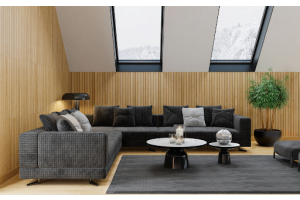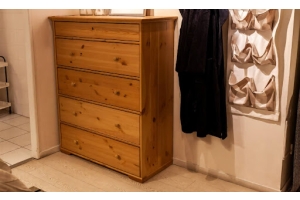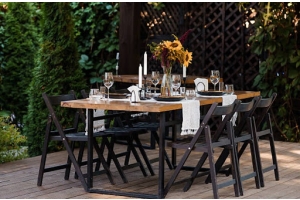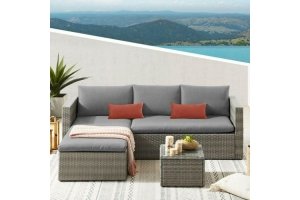
When it comes to choosing the perfect wardrobe for your space, one of the fundamental decisions you'll face is whether to opt for sliding doors or hinged doors. Each style brings its own set of advantages and considerations, catering to different needs and preferences. In this comprehensive guide, we delve into the key differences between sliding door and hinged door wardrobes from the perspective of usability. We will explore factors such as space utilisation, aesthetic appeal, ease of access, and practicality. Whether you're renovating your bedroom or planning a new storage solution for your living rooms, we hope that that will be able to help you make a confident decision that best suits your lifestyle.
Hinged wardrobe

Hinged door wardrobes, also known as swing door wardrobes, operate on a simple yet effective mechanism. These wardrobes feature doors that are attached to the frame with hinges, allowing them to swing open and close outside the cupboard space just like traditional doors in a room. Hinged wardrobes typically come with a variety of door configurations, ranging from single-door setups to multiple doors spanning the width of the wardrobe.
Pros:
Easily Accessible
One of the standout features of hinged door wardrobes is their easy accessibility to the wardrobe essentials. These wardrobes provide full and immediate access to the entire wardrobe interior when doors are fully opened. This makes it easy to view and organise the clothing and belongings stored inside the wardrobe and saves energy while cleaning the wardrobe. Moreover, hinged wardrobes often include options for internal organisation systems like shelves, drawers, and hanging rails, which can further enhance accessibility by providing designated spaces for different items.
Variety Of Customization Options:
Hinged door wardrobes also provide extensive customization options. For example, hinged wardrobes can accommodate single-door designs for compact spaces or multiple-door setups spanning the entire width of the wardrobe, adapting to the layouts.
Beside that you can also attach hooks or mini-baskets to the interior of the hinged wardrobe door to hang your purses, belts or small accessories. On the exterior of the hinged wardrobe door, you can use stickers or flexes to decorate it according to your taste. This feature is not suitable for sliding wardrobe doors as the doors are not fixed in their place and have to go in front of the other to open up and so the locations you paste on the doors may wear off.
Another plus point is that most of the furniture stores in the UK provide complete wardrobe sets matching to your wardrobe exterior so that gives an impression that your wardrobe is a piece of your holistic room decor.

Suitability For Rough Usage
Hinged door wardrobes are highly suitable for rough usage due to their robust construction and easy operation. Opening wardrobes feature doors that are securely mounted on hinges, making them resilient to everyday wear and tear caused by frequent opening and closing without compromising functionality or durability.
This sturdiness also makes it a reliable choice for households with active children who may be less mindful of handling delicate sliding mechanisms. Additionally, hinged wardrobes often come with options for soft-close hinges, which prevent doors from slamming shut, ensuring a quieter closing experience that is conducive to a calm environment, especially in children's rooms.
Easy Maintenance
Maintaining a hinged door wardrobe requires minimal effort as compared to sliding wardrobe’s railing. Regular dusting with a soft cloth or gentle vacuuming with a brush attachment is enough to keep the surfaces clean. For deeper cleaning, a mild detergent solution and a soft cloth can be used to wipe down the doors and frame. Most of the modern open door wardrobes are self-lubricating mechanisms skipping this process too, making them a practical choice for busy households.
Versatility for all kind of living spaces
Hinged door wardrobes seamlessly integrate into various types of living spaces with ease. Whether in a spacious master bedroom, a compact apartment, or even a hallway or dressing area, hinged wardrobes offer flexibility in design and placement. Their customizable door configurations and wide range of finishes allow them to complement diverse interior styles.
Cons
Takes Up Floor Space
One notable drawback of hinged door wardrobes is their requirement for adequate floor space to open fully. This means that you need to have enough clearance in front of the wardrobe to accommodate the full swing of the doors. Typically, a swinging door wardrobe requires at least half of its width plus a few extra inches on each side to open comfortably. For instance, a wardrobe with doors spanning 60 inches would ideally need an open area of about 30 inches on one side for the door to swing fully open. This necessity for floor space can be challenging in smaller rooms, tight corners or narrow hallways where every inch of floor space is valuable.
Traditional Look
Hinged door wardrobes have a more traditional appearance compared to modern alternatives: sliding door wardrobes. Hinged wardrobes typically feature doors that swing open on hinges, may not align with contemporary or minimalist interior design preferences that favour clean lines and streamlined aesthetics. Additionally, the visible presence of hinges and handles on hinged wardrobes can contribute to a more cluttered visual effect, especially in rooms where space is limited and sleek. While there are many stylish options available in hinged wardrobes with various finishes and designs, their inherent design may not appeal to those seeking a more modern or minimalistic look for their living spaces.

Sliding Door Wardrobe

Now comes sliding wardrobes. It represents a modern and space-efficient solution to storage needs, offering a distinctive alternative to traditional hinged door designs. These wardrobes feature doors that glide along tracks horizontally. This sliding mechanism allows for smooth and silent operation and is renowned for their sleek appearance and contemporary feel, often integrating seamlessly into modern interiors with their minimalist profiles and clean lines.
Pros
Clean and Esthetic Looks
The top advantage of sliding door wardrobes is their clean and aesthetic appearance, which complements modern interior designs effortlessly. Sliding wardrobes often feature sleek, minimalist profiles that contribute to a streamlined and contemporary look in any room. Additionally, sliding wardrobes can be designed with luxurious materials like high-gloss finishes or sophisticated wood veneers, adding a touch of elegance to 21st-century homes. Their smooth, unobtrusive operation and stylish appearance make sliding door wardrobes a favoured choice for those seeking both functionality and aesthetic appeal in their living spaces.

Suitability for Small Space
Sliding door wardrobes are exceptionally well-suited for small spaces, especially in bedrooms where maximising floor area is essential. Sliding wardrobes operate horizontally along tracks, making them ideal wardrobes for tight corners or narrow areas. This sliding mechanism not only saves valuable floor space but also allows for efficient use of vertical space, as the doors do not protrude into the room when opened.
They can be customised with various finishes such as mirrored surfaces, which not only enhance the visual appeal but also create a sense of spaciousness by reflecting light and making the room appear larger. This makes mirrored sliding wardrobes particularly popular in smaller spaces where maximising the perception of openness is desired.
Smooth Moving
Sliding door wardrobes are prized for their smooth and silent operation, enhancing the overall tranquillity of living spaces. The sliding mechanism, typically consisting of high-quality tracks and rollers, allows the doors to glide effortlessly along their designated path. This smooth movement not only makes accessing the wardrobe contents a quiet and pleasant experience but also minimises the risk of wear and tear over time. Unlike hinged doors that may creak or require occasional adjustments, sliding wardrobes maintain their quiet functionality with minimal maintenance creating a serene environment conducive to relaxation and daily routines.
Cons:
Cleaning
The hardest aspect of sliding door wardrobes from a women’s point of view is the challenge of cleaning the doors and tracks. Sliding wardrobes have tracks that can accumulate dust, dirt, and debris over time. These tracks require regular cleaning to ensure smooth operation and to prevent buildup that could affect the doors' movement. Cleaning the tracks thoroughly often involves using a vacuum cleaner with a narrow attachment to remove debris, followed by wiping with a damp cloth to remove any remaining dirt. This cleaning process becomes hectic considering that a little spill or even biscuit pieces can block the wardrobe entrance and will require cleaning which is not possible with hands.
Difficult Accessibility
One notable drawback of sliding door wardrobes is that they may not be as easily openable as hinged door wardrobes, especially for those who prefer quick and effortless access to their belongings. While sliding doors are designed to glide smoothly along tracks, they can sometimes require a bit more effort to open if the doors are heavy. Their contemporary hinged doors offer instant access to the entire wardrobe interior while sliding wardrobes covers half of the wardrobe when one door slides . This makes cleaning and organising difficult and gives them a negative point from individuals seeking convenience and quick accessibility in their daily routines.

Conventional Usage
Sliding door wardrobes have a conventional association with bedrooms, which may limit their application in other spaces throughout the home. While sliding wardrobes are highly functional and space-efficient in bedrooms, they may not always seamlessly integrate into other areas such as living rooms, hallways, or home offices. The modern aesthetic and minimalist appeal that make sliding wardrobes ideal for bedrooms may not always complement the decor or functionality needs of these other spaces, where different storage solutions or design considerations may be preferred. Additionally, the use of sliding wardrobes outside of bedrooms can sometimes appear less versatile or adaptable compared to hinged door wardrobes, which are often seen as more traditional and suitable for a wider range of interior settings.
Comparison Of Hinged Vs Sliding Wardrobe:

What kind of spaces it suits
Hinged wardrobes are highly versatile and suited for bedrooms, hallways, and dressing rooms due to their straightforward access and traditional design. They offer easy viewing and access to the entire wardrobe interior, making them ideal for organising and selecting items efficiently. In contrast, sliding wardrobes excel in maximising space efficiency, particularly in bedrooms where their horizontal operation along tracks eliminates the need for clearance space. Their modern aesthetic with customizable finishes like mirrored surfaces or frosted glass also makes them suitable for contemporary interiors, although they may be less traditional and adaptable outside of bedroom settings.
Installation Process
When comparing hinged and sliding wardrobes in terms of installation, hinged wardrobes generally have a simpler and quicker process. Installation involves attaching hinges and securing doors to the frame, making it more accessible for DIY projects. Adjustments for door alignment may be needed but are typically manageable. In contrast, sliding wardrobes require more intricate installation due to mounting tracks and ensuring level alignment for smooth door operation. This complexity often necessitates professional installation to ensure tracks are securely anchored and doors slide effortlessly. Overall, while hinged wardrobes are straightforward for DIY installation, sliding wardrobes may require more expertise and precision during setup.
Durability
In terms of durability, both hinged and sliding wardrobes offer distinct advantages and considerations. Hinged wardrobes typically feature doors attached to sturdy hinges, which are straightforward mechanisms known for their reliability over time. This simplicity often contributes to a longer average lifespan, with hinged wardrobes commonly lasting 15-20 years or more with proper maintenance. Maintenance for hinged wardrobes usually involves periodic checks and adjustments to hinges and handles, ensuring smooth operation and preventing wear. On the other hand, sliding wardrobes, with their tracks and rollers, require careful maintenance to maintain durability. Tracks must be kept clean and free from debris to prevent doors from sticking or derailing. While sliding wardrobes can also last 15-20 years or longer with proper care, their lifespan may be influenced more significantly by the quality of tracks and rollers and the regularity of maintenance. Therefore, while hinged wardrobes may have a slight edge in durability due to their simpler mechanisms, both types can offer long-lasting storage solutions when properly maintained.
Cost
When comparing hinged and sliding wardrobes based on cost, several factors come into play. Hinged wardrobes generally tend to be more cost-effective upfront compared to sliding wardrobes. Moreover, hinged wardrobes are often easier to find in standard sizes and designs, further contributing to their affordability. On the other hand, sliding wardrobes typically involve more complex systems, including tracks, rollers, and sometimes specialised materials like mirrored or frosted glass doors, which can increase both the purchase price and installation expenses. Additionally, the need for precise installation of tracks and alignment of sliding doors may require professional assistance, adding to the overall cost. Overall, hinged wardrobes generally offer a more budget-friendly wardrobe option for those looking to minimise initial investment in their storage solutions.
Sliding Vs. Hinged Wardrobe: Which One Should You Choose?
When deciding between sliding and hinged wardrobes, two critical factors should guide your decision: space and style preferences. If you're working with limited space or desire a modern, streamlined look, sliding wardrobes are an excellent choice.
On the other hand, hinged wardrobes offer easy accessibility to the entire wardrobe interior and are versatile in various room settings, making them ideal for those prioritising traditional design elements or seeking straightforward functionality without the need for additional clearance.
For those unsure, we recommend assessing your room layout and aesthetic preferences first. Opt for sliding wardrobes if you value space efficiency and a modern appearance, while hinged wardrobes are preferable if you prioritise easy access and a timeless design that fits seamlessly into different areas of your home.





